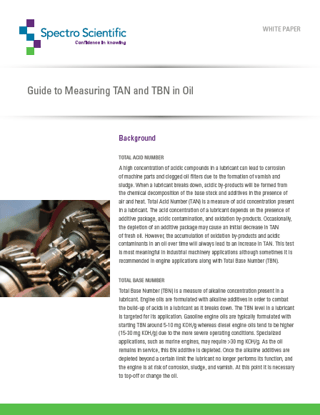Download your free guide
Guide to Techniques for Measuring TAN and TBN in Oil
TOTAL ACID NUMBER
A high concentration of acidic compounds in a lubricant can lead to corrosion of machine parts and clogged oil filters due to the formation of varnish and sludge. When a lubricant breaks down, acidic by-products will be formed from the chemical decomposition of the base stock and additives in the presence of air and heat. Total Acid Number (TAN) is a measure of acid concentration present in a lubricant. The acid concentration of a lubricant depends on the presence of additive package, acidic contamination, and oxidation by-products. Occasionally,
the depletion of an additive package may cause an initial decrease in TAN of fresh oil. However, the accumulation of oxidation by-products and acidic contaminants in an oil over time will always lead to an increase in TAN. This test is most meaningful in industrial machinery applications although sometimes it is recommended in engine applications along with Total Base Number (TBN).
TOTAL BASE NUMBER
Total Base Number (TBN) is a measure of alkaline concentration present in a lubricant. Engine oils are formulated with alkaline additives in order to combat the build-up of acids in a lubricant as it breaks down. The TBN level in a lubricant is targeted for its application. Gasoline engine oils are typically formulated with starting TBN around 5-10 mg KOH/g whereas diesel engine oils tend to be higher (15-30 mg KOH/g) due to the more severe operating conditions. Specialized applications, such as marine engines, may require >30 mg KOH/g. As the oil
remains in service, this BN additive is depleted. Once the alkaline additives are depleted beyond a certain limit the lubricant no longer performs its function, and the engine is at risk of corrosion, sludge, and varnish. At this point it is necessary to top-off or change the oil.

Methods of TAN and TBN in Oil
- Potentiometric Titration
- Colorimetric Titration
- Field Test Kits
- Infrared Spectroscopy






